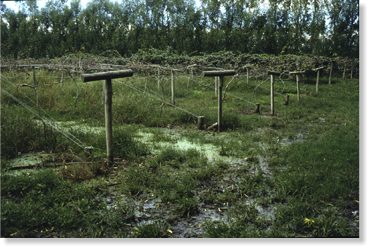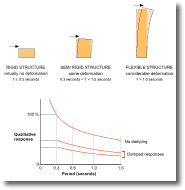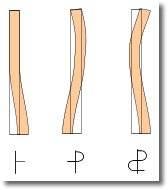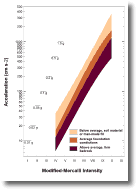
|
|||||||||||||||||||
|
|
|||||||||||||||||||
Impact of Earthquakes
During an earthquake the ground surface moves in all directions. The most damaging effects on buildings are usually the horizontal movements because most structures are designed to withstand vertical gravity loads. Ambrose and Vergun (1990) identify the general effects of earthquakes as:
Structures will be shaken in all directions during an earthquake. The force effect caused by this motion is generally directly proportional to the dead weight of the structure, which also bears on the dynamic response of the structure. Two other factors that will influence the structure's response are: 1. The structure's resonance (determined by the mass, stiffness and size of the structure; Fig. 14).
2. The structures efficiency in energy absorption (determined by the elasticity of the structure, stiffness of supports, number of separate moving parts etc.). The relationship between the resonance of the earthquake and the structure is a major concern. This relationship is shown as spectrum curves (Fig. 14). Earthquakes have their major direct force effect on structures with short resonance (e.g. small or squat buildings, structures with stiff lateral resistive systems). Resonance of tall towers and multi-storey buildings may be so long that different parts of the building move in opposite directions simultaneously (Fig. 15) All structures have a natural resonance and if a building has a frequency similar to that of the seismic waves then the movement of the building is amplified by resonance and severe damage may result. Different parts of a single building may have different frequency responses, leading to differential damage, e.g. collapse of a tower while a low storey part of the same building is undamaged.
At Mexico City the peak acceleration of the earthquake corresponded to an estimated return period of 50 years. However, as the earthquake shock wave passed thorough the clays beneath the city they were amplified 6 times. Surface waves, just like ocean waves, crossed back and forth across the basin for nearly three minutes. The wavelengths of these waves (50 m) closely matched the dimensions of the bases of many of the city's buildings. Peak accelerations for the surface seismic waves matched those for the buildings which resonated, amplifying the shaking of the buildings sufficiently to cause them to collapse. Liquefaction Liquefaction occurs when shear waves distort the structure of soils, causing a soil to suddenly collapse. Soil comprises grains which are in contact with one another. Below the water table the spaces (voids) between these grains are filled with water. As long as the grains stay in contact the soil will retain its strength. However, if pressure exceeding the weight of the soil is put upon the water in the voids the soil dilates, and the soil turns into a slurry which behaves like a fluid and has virtually no bearing strength. This process can happen very quickly and structures built on top of soil which behaves in this way will sink into the slurry. Liquefaction can be triggered by earthquakes. Shear waves disrupt and reorganise the soil particles which decreases void space and thus increases pore pressure with pressure increasing with each passing shock. The size of the grains in the soil is an important factor. Fine-grained soils, with a large proportion of silt and clay, are less likely to liquefy because the capillary water tension between gains is high. Fine- to medium-grained sands do not allow rapid draining of pore water but have void spaces large enough to make capillary cohesion irrelevant. These sand sizes are common in recently deposited marine and river sediments, and so liquefaction commonly occurs in these materials during earthquakes (Bryant 1991, 203-206). Liquefaction is represented by lateral spreads (movement of blocks of soil over a liquefied layer beneath the surface), flow failures (fluidised soils moving down slope as a slurry) and loss of bearing strength. During the 1906 San Francisco earthquake, liquefaction spreads in estuarine muds and landfill near the harbour broke water mains, hampering fire fighting. Liquefaction was also a problem during the 27 March 1964 Alaskan earthquake where nearly every bridge in the affected area was destroyed by lateral spreads. On 16 June, 1964 a major earthquake struck 60 km north of Niigata city, Japan. The earthquake produced maximum ground accelerations of 1.58 cm s-2 (i.e. about MM II, not excessive). The earthquake, however, liquefied river sediments on Shinano River, across which the city had expanded, and large apartment blocks sank into the liquefied sediments. Although liquefaction generally occurs in water-saturated soils,
it can also involve air. During the 16 December 1920 Kansu earthquake,
200,000 people were buried by landslides triggered by liquefaction
of fine-grained loess. The shear strength of the loess was exceeded
by the earthquake effects but low permeability of the fine-grained
soil prevented air from escaping from the loess, which then liquefied.
A tsunami is a series of large ocean waves generated by impulses from geophysical events, such as earthquakes, landslides and volcanic eruptions, on the ocean bottom or along the coastline. The word Tsunami was coined by the Japanese and translates literally to "great wave in harbour". The most common event that generates tsunamis is submarine faulting which causes part of the ocean floor to be vertically displaced. Only a small number of submarine earthquakes result in tsunamis. Most have a small spatial effect or are too low in magnitude to cause vertical displacement of the ocean floor. Generally, only those earthquakes with a Richter magnitude > 6.6, and shallow focal depths (< 50 km) are likely to be accompanied by tsunamis. The abrupt submarine faulting and vertical displacement of the sea floor causes rapid upward movement of the overlying water column, forcing it into a wave-like turbulence, which is expressed as a series of seismic sea waves. In the ocean these are barely detectable and difficult to tell from normal swells. They have low wave heights (~ 1 m) and long wavelengths (100 km) and travel at speeds up to 1000 km/hr. A tsunami may comprise numerous waves, which may arrive at the shoreline minutes or hours apart. The April 1946 Alaskan earthquake triggered a tsunami which damaged coastal areas in the Aleutian Islands, and also crossed the Pacific Ocean to strike Hilo Bay in Hawaii. A 30-m high wave, travelling at approximately 780 km/hr, killed five people. At Hilo Bay tsunami waves crested more than 19 m above normal water level, and waves swept more than 600 m inland. Some 500 homes and businesses were destroyed and thousands damaged; 96 people were killed. Hawaii was also affected by tsunamis following the Richter magnitude 8.6, 22 May 1960 Chilean earthquake, which generated a Pacific-wide tsunami. Tsunamis and their effects are fully explored in another module.
|
|||||||||||||||||||
|
|||||||||||||||||||






